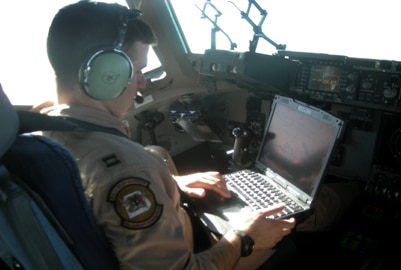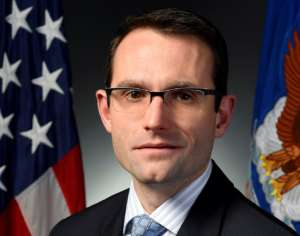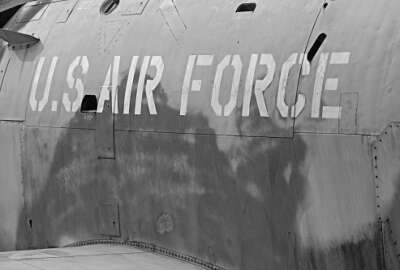
Air Force rethinking how acquisition and software fit together
The Air Force wants program managers to be able to spot good code in software.
The Air Force’s top acquisition official wants to train some program managers to better understand the world of software, and he’ll soon work with the service’s Education and Training Command to make it happen.
At the same time, Will Roper, the Air Force’s assistant secretary for acquisition, technology and logistics, wants software experts in the service to act as coding ambassadors to oversee some aspects of a program as systems are procured and developed.

Not all procurement managers are versed in coding and tech. But unless the Air Force is buying something as simple as a shoe, it’s likely software is going to be involved. Even helmets used by fighter pilots on F-35s use software to integrate sensors that make enemies easier to spot.
Roper said he wants to bridge the gap between program managers and “nerdy” tech by certifying some procurement experts in the ins-and-outs of software development.
“We train people to be acquisition professionals and we call them materiel leaders and senior materiel leaders. We have certifications that say you can have this much control, we don’t have that for software,” Roper told reporters Wednesday at the Pentagon. “I don’t think you need the same training to lead the software team that you need to build a strategic bomber.”
The Air Force will soon designate software leaders and senior software leaders within the acquisition workforce to decide how much software coding talent can work under that person. Those leaders will be able to spot good code.
The next step is creating a formal certification, which Roper hopes to develop in a partnership with Air Force Education and Training Command.
“We have to be able to provide that training to them,” Roper said, as opposed to requiring them to take online courses or get the education somewhere else.
The Air Force already has a pool of software experts it can draw on to work within procurement teams.
The service set up its Kessel Run hub in Boston last year. The project builds and delivers software and applications to digitize and simplify how airmen organize combat air forces.
Last fall, the Air Force set up the Program Executive Office Digital to do the same thing for every air operations center.
“Some of our really great coders and code leaders at Kessel Run are not acquisition professionals, they are operators who know how to code,” Roper said. “Those people can come in and they can lead a coding team. They know what they need as an operator and they can see through B.S. versus not. My idea is I should be able to certify these people and use them to build software programs.”
Related Stories
“There’s a chance for a really good long term-benefit,” Roper said.
Software hubs
Hubs like Kessel Run are beginning to proliferate. The Air Force is currently setting up a hub at Space and Missile Systems Center.
“They’re picking a Star Trek name to keep the universe of geeks happy,” Roper said.
Another hub is going into the Air Force’s Distributed Common Ground System and another in the Air Force Sustainment Center.
The Air Force expects some sort of software procurement and development assistance to take root throughout its acquisition components, but how it will do that is still to be determined.
Right now, the confederation of hubs and the Air Force Digital Service provide advice and support. Roper said program executive officers (PEOs) need to learn to use these hubs.
“Not using them is like a tool in your toolbox you don’t know how to use,” Roper said. “The hubs have been very kind with their time and jumping in with our PEOs up at Hanscom Air Force Base, or down in Montgomery, Alabama, with the PEO for digital business enterprise systems. They are looking to make the pivot; they just need the advice to know what’s real and what’s pretend.”
Roper said he’s still feeling out how these hubs will be ingrained within Air Force procurement.
“The last thing I like to focus on is process and organization, and the government loves to do that,” Roper said. “There’s nothing we love more than an organizational chart and process to go with it before you’ve even seen the results of it. I’m really trying to focus on culture and results and [we] will organize around what’s working.”
Roper said he is confident the Air Force needs more hubs that can “pump out code.”
Software matters
Last year, Roper pointed out software as the Air Force’s biggest procurement issue.
“Software intensive programs are almost all over cost, over schedule,” he said.
Roper said one of his most imperative duties is to get the Air Force to a point where it can do agile software development, a process that delivers new updates rapidly and consistently, fixing bugs along the way.
“We’re just not accustomed, as acquisition professionals, to having deliverables on a monthly basis or on a weekly basis,” Roper said. “We’re not accustomed to testing things, to operationally certifying things. You could imagine in a future war where we are changing software on a daily basis as a necessary factor for winning.”
Copyright © 2024 Federal News Network. All rights reserved. This website is not intended for users located within the European Economic Area.
Scott Maucione is a defense reporter for Federal News Network and reports on human capital, workforce and the Defense Department at-large.
Follow @smaucioneWFED





